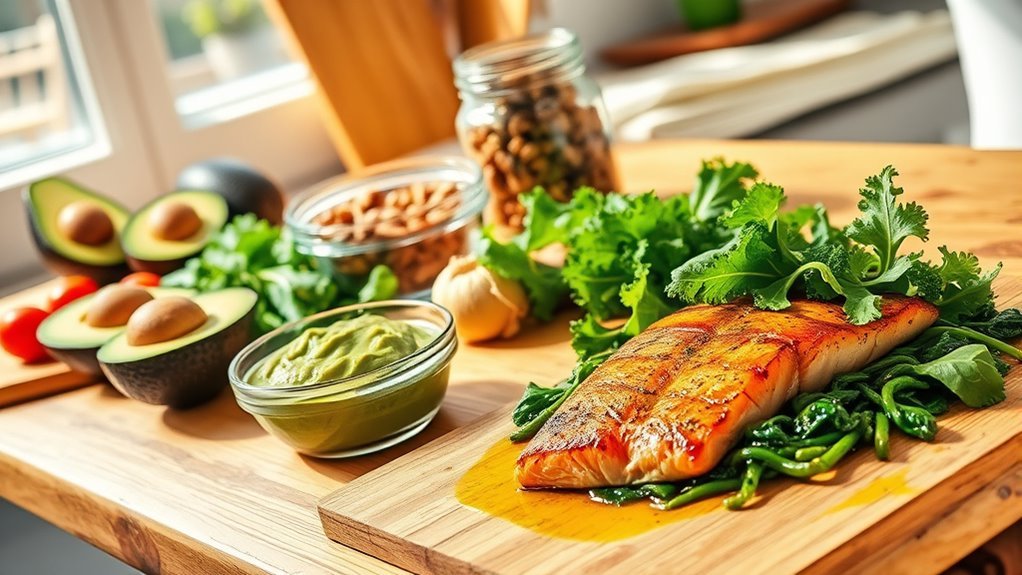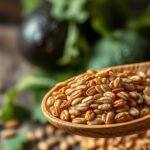To start the keto diet, you’ll need to drastically cut your carbohydrate intake and increase healthy fats. Focus on foods like avocados, olive oil, leafy greens, fatty fish, and nuts. Avoid sugars, grains, and starchy vegetables to maintain ketosis. Meal prep can help you stay on track, along with mindful eating and hydration. Organizations and tracking your meals will also enhance your success. There’s more to discover about maintaining commitment and effective meal strategies.
Understanding the Ketogenic Diet
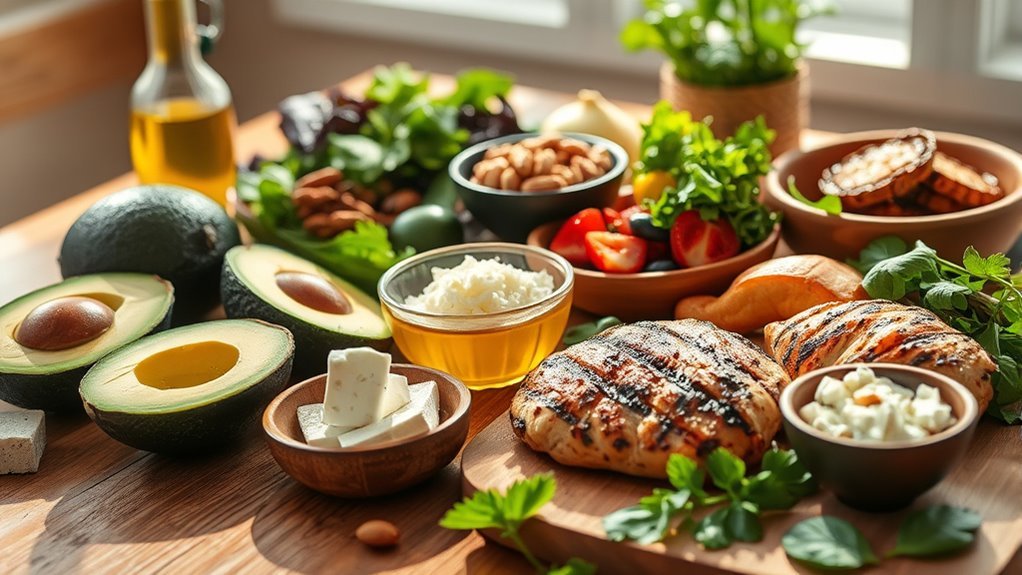
When you’re exploring the ketogenic diet, it’s essential to understand its core principles and how it works. Originating in the 1920s as a treatment for epilepsy, the ketogenic diet focuses on drastically reducing carbohydrate intake while increasing fat consumption. This shift encourages your body to enter a state of ketosis, where it burns fat for fuel instead of glucose. However, there are many keto misconceptions, such as the belief that all fats are bad or that the diet is unsustainable long-term. In reality, when done correctly, the ketogenic diet can be flexible and tailored to your needs. Understanding its history and principles helps you make informed choices, empowering you to embrace this lifestyle with confidence and freedom.
Benefits of the Keto Diet
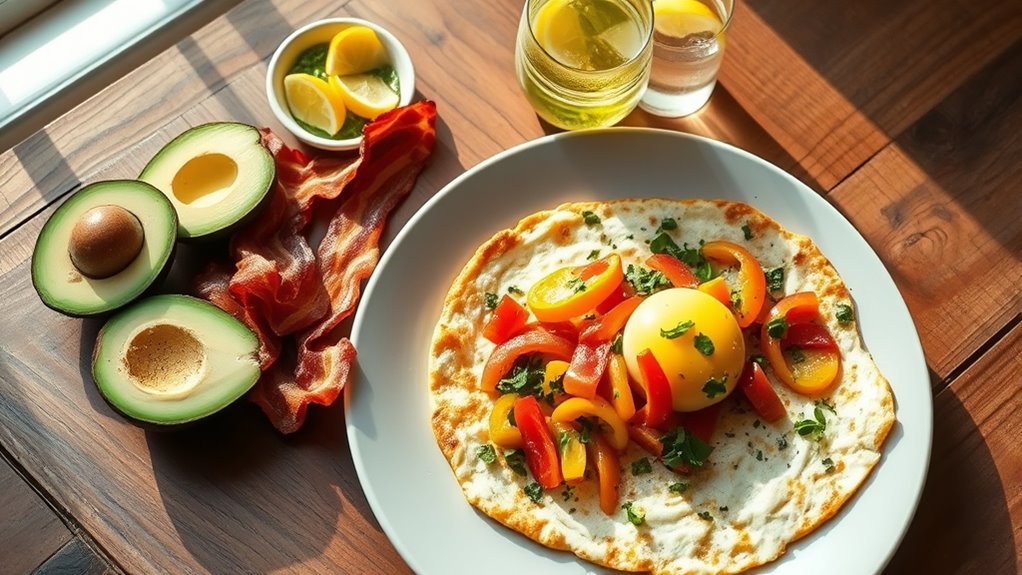
While many people may initially consider the ketogenic diet for weight loss, it offers a range of benefits that extend beyond shedding pounds. One notable advantage is enhanced mental clarity. Many who adopt the keto lifestyle report improved focus and cognitive function, attributed to the brain’s efficiency in using ketones for energy. Additionally, the diet can stabilize blood sugar levels, reducing cravings and promoting sustained energy throughout the day. This stability enables you to enjoy a greater sense of freedom from constant hunger. Furthermore, the keto diet may support heart health by improving cholesterol levels and reducing inflammation. Ultimately, embracing keto could lead not just to weight loss, but to a more vibrant, energetic, and mentally sharp you.
Foods to Eat on Keto
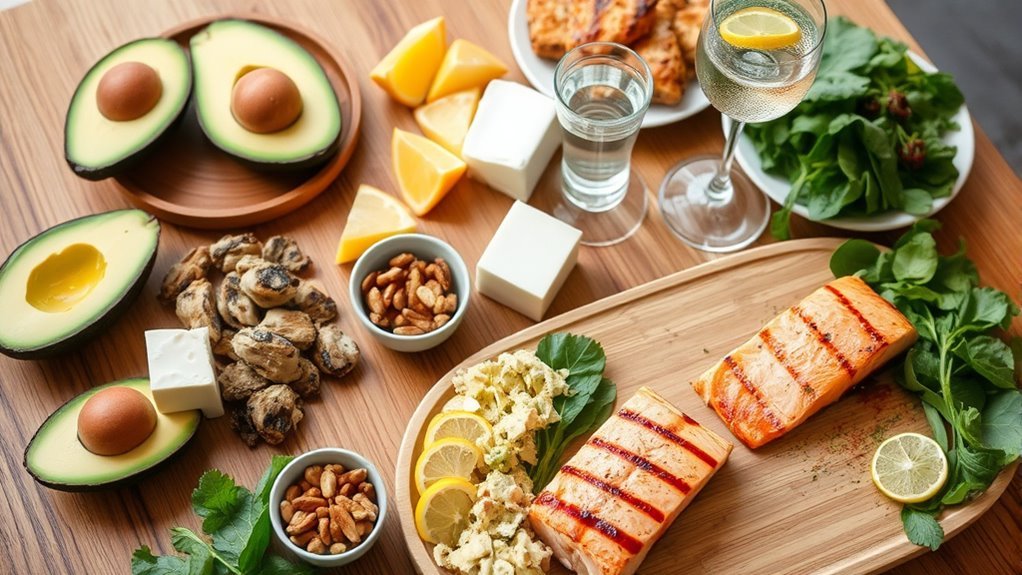
When you’re following a keto diet, focusing on healthy fat sources and low-carb vegetables is essential. Incorporating foods like avocados, olive oil, and leafy greens can help you maintain ketosis while providing crucial nutrients. Understanding which foods fit into this framework will make your keto journey smoother and more enjoyable.
Healthy Fats Sources
Incorporating healthy fats into your diet is essential for successfully following the keto lifestyle, as these fats serve as your primary energy source while helping to keep you satiated. Consider using avocado oil and olive oil for cooking, as they’re rich in monounsaturated fats. Coconut butter and grass-fed ghee are great for adding creaminess to your meals. Nut butters provide a delicious, nutrient-dense option for snacks. Don’t forget fatty fish like salmon, which offers omega-3 fatty acids. Cheese varieties can enhance flavors while providing healthy fats, and egg yolks are a powerhouse of nutrients. For added crunch, sprinkle chia seeds or flax seeds on your dishes to boost fiber and healthy fats. Enjoy the freedom of delicious choices!
Low-Carb Vegetables Choices
Including low-carb vegetables in your keto diet is essential for maintaining nutritional balance while keeping your carbohydrate intake in check. These keto friendly greens not only provide essential vitamins and minerals but also add fiber to your meals, promoting digestive health. Here are some great low carb options to include:
- Spinach – Packed with iron and vitamins A, C, and K.
- Zucchini – A versatile veggie that can be spiralized into noodles.
- Broccoli – Rich in fiber and antioxidants, perfect for roasting or steaming.
- Cauliflower – A great substitute for rice or potatoes in many dishes.
Incorporating these vegetables can enhance your meals while supporting your keto lifestyle. Enjoy the freedom of flavorful, nutritious eating!
Foods to Avoid on Keto
While starting on a keto diet, it’s crucial to understand which foods can sabotage your efforts. One of the main keto food restrictions is avoiding sugar. This includes obvious sources like candies and desserts, but also hidden sugars found in sauces, dressings, and processed foods. Grains are another category to steer clear of; bread, pasta, and rice can quickly kick you out of ketosis. Starchy vegetables like potatoes and corn should also be limited, as they can spike your carb intake. Additionally, high-sugar fruits such as bananas and grapes aren’t ideal. By focusing on these restrictions, you’ll better maintain your path to health and freedom while enjoying your keto journey.
Meal Planning for Success
To succeed on the keto diet, effective meal planning is vital. You’ll want to stock up on essential keto ingredients, utilize weekly meal prep tips, and explore satisfying snack ideas that align with your goals. By organizing your meals, you can stay on track and enjoy the benefits of this lifestyle.
Essential Keto Ingredients
When starting on a keto diet, selecting the right ingredients is essential for achieving your health goals. Stocking your kitchen with keto pantry essentials guarantees you have the must-have ingredients on hand for flavorful meals. Here are four key items to include:
- Healthy Fats: Avocado oil, coconut oil, and olive oil are great for cooking and dressings.
- Low-Carb Vegetables: Spinach, broccoli, and zucchini add nutrients without the carbs.
- Protein Sources: Grass-fed meats, eggs, and fatty fish provide essential amino acids.
- Nuts and Seeds: Almonds, chia seeds, and flaxseeds offer healthy fats and fiber.
These ingredients not only support your keto journey but also empower you to create diverse and satisfying meals while enjoying the freedom of choice.
Weekly Meal Prep Tips
Effective meal prep is essential for staying on track with your keto diet, as it helps you avoid last-minute unhealthy choices. By planning ahead, you can guarantee portion control, experiment with flavor variety, and streamline your grocery shopping. Here’s a simple table to help organize your weekly meal prep:
| Day | Meal Type | Kitchen Tools |
|---|---|---|
| Monday | Batch Cooking | Slow Cooker |
| Tuesday | Ingredient Storage | Glass Containers |
| Wednesday | Recipe Organization | Recipe Binder |
| Thursday | Meal Timing | Meal Prep Containers |
| Friday | Grocery Shopping | Shopping List |
Utilizing these tips, along with effective time management, allows you to enjoy the freedom that a well-planned keto diet brings.
Snack Ideas for Keto
Snacking on a keto diet can be both satisfying and vital for maintaining energy levels between meals. Choosing the right keto snacks is important, as they can help you stay on track with your low-carb lifestyle. Here are some healthy options for quick bites:
- Nut Varieties: Almonds, walnuts, and pecans make excellent low-carb treats.
- Cheese Snacks: String cheese or cheese crisps provide a delicious, satisfying crunch.
- Veggie Dips: Pair celery or cucumber slices with guacamole or ranch for a revitalizing snack.
- Fat Bombs: These tasty little bites are packed with healthy fats and can satisfy sweet cravings with chocolate snacks or protein bars.
Managing Keto Flu
Although many people experience the so-called “keto flu” when shifting to a ketogenic diet, managing its symptoms can greatly ease the adjustment period. Common keto flu symptoms include fatigue, headaches, and irritability, stemming from carbohydrate withdrawal. To combat these, make certain you’re staying well-hydrated and consuming enough electrolytes, like sodium, potassium, and magnesium. Incorporating healthy fats and fiber can also help in managing cravings, keeping you satisfied longer. Eating low-carb snacks, like nuts and cheese, can curb hunger and stabilize your energy levels. Remember, this phase is temporary, and your body will adjust. By taking proactive steps, you can minimize discomfort and embrace the freedom that comes with a successful keto lifestyle.
Tips for Staying on Track
Staying on track with your keto diet can feel challenging at times, especially when faced with temptations or social situations. Here are some tips to help you maintain your commitment and enjoy freedom in your choices:
- Plan Ahead: Prepare keto-friendly meals and snacks to avoid impulsive eating.
- Mindful Eating: Focus on your meals. Savor each bite to enhance satisfaction and reduce cravings.
- Communicate: When dining socially, share your dietary preferences with friends. This helps them support you.
- Stay Hydrated: Drink plenty of water throughout the day; it can help curb hunger and improve your overall well-being.
Tracking Your Progress
Maintaining your commitment to the keto diet involves more than just sticking to your meal plan; tracking your progress can provide valuable insights into how well you’re adhering to the lifestyle changes. By using a food diary or keto apps, you can log daily meals and track weight measurements and body measurements. Regular goal setting and weekly reviews keep you focused and motivated. Consider partnering with accountability partners to share your visual progress, which can create mindset shifts that enhance your commitment.
| Date | Weight Measurement | Notes |
|---|---|---|
| Week 1 | 180 lbs | Started keto |
| Week 2 | 178 lbs | Feeling energized |
| Week 3 | 175 lbs | Cravings reduced |
| Week 4 | 173 lbs | Increased exercise |
| Week 5 | 170 lbs | Goal achieved! |
